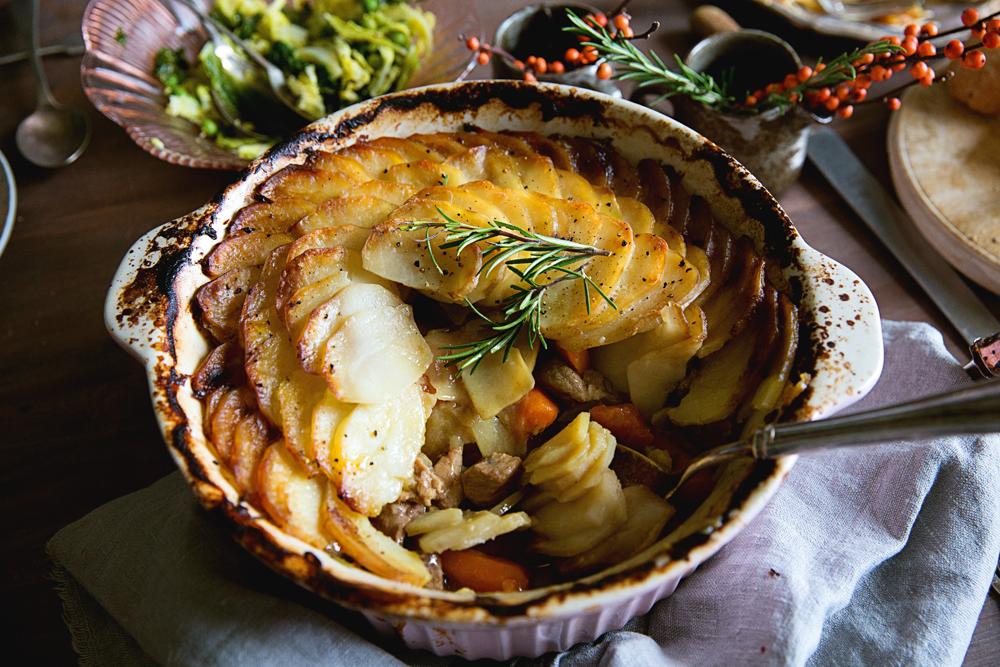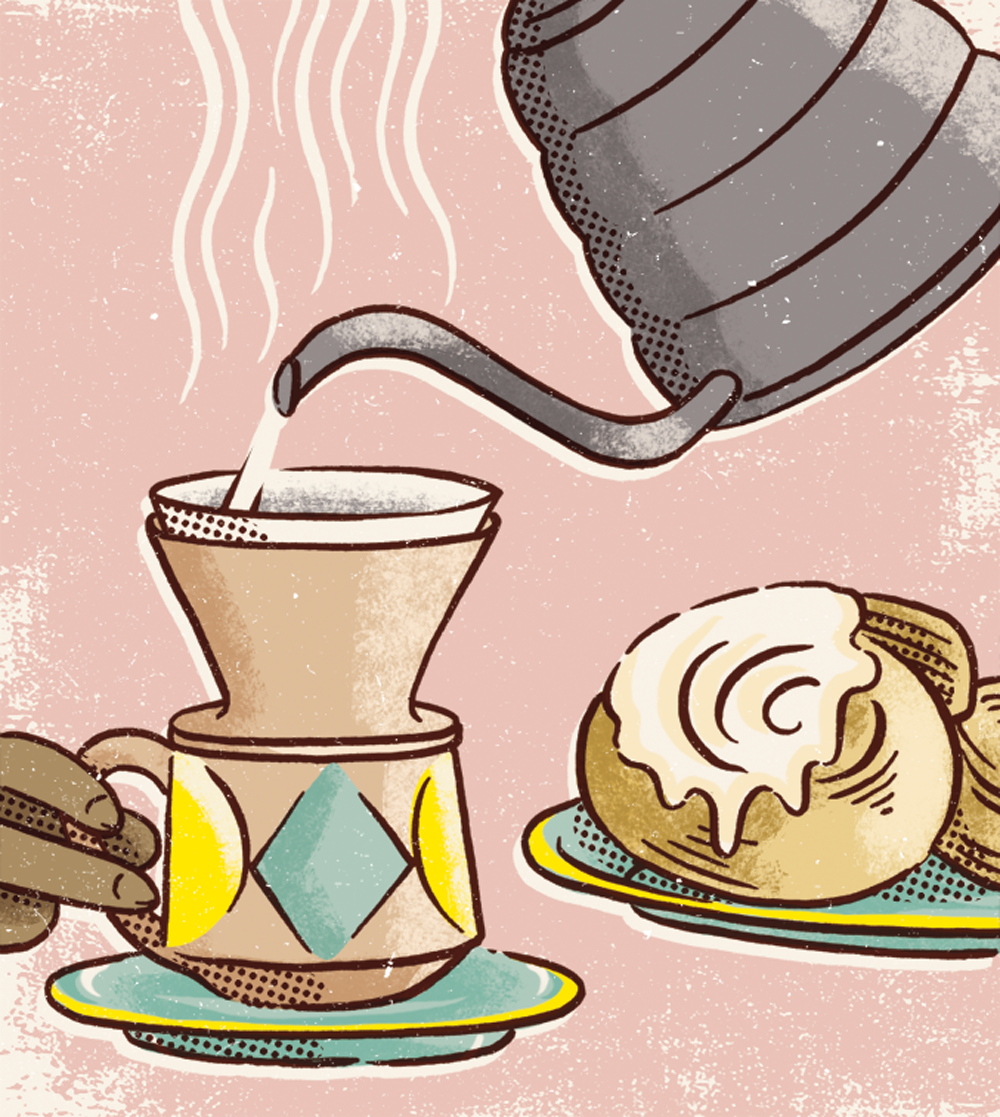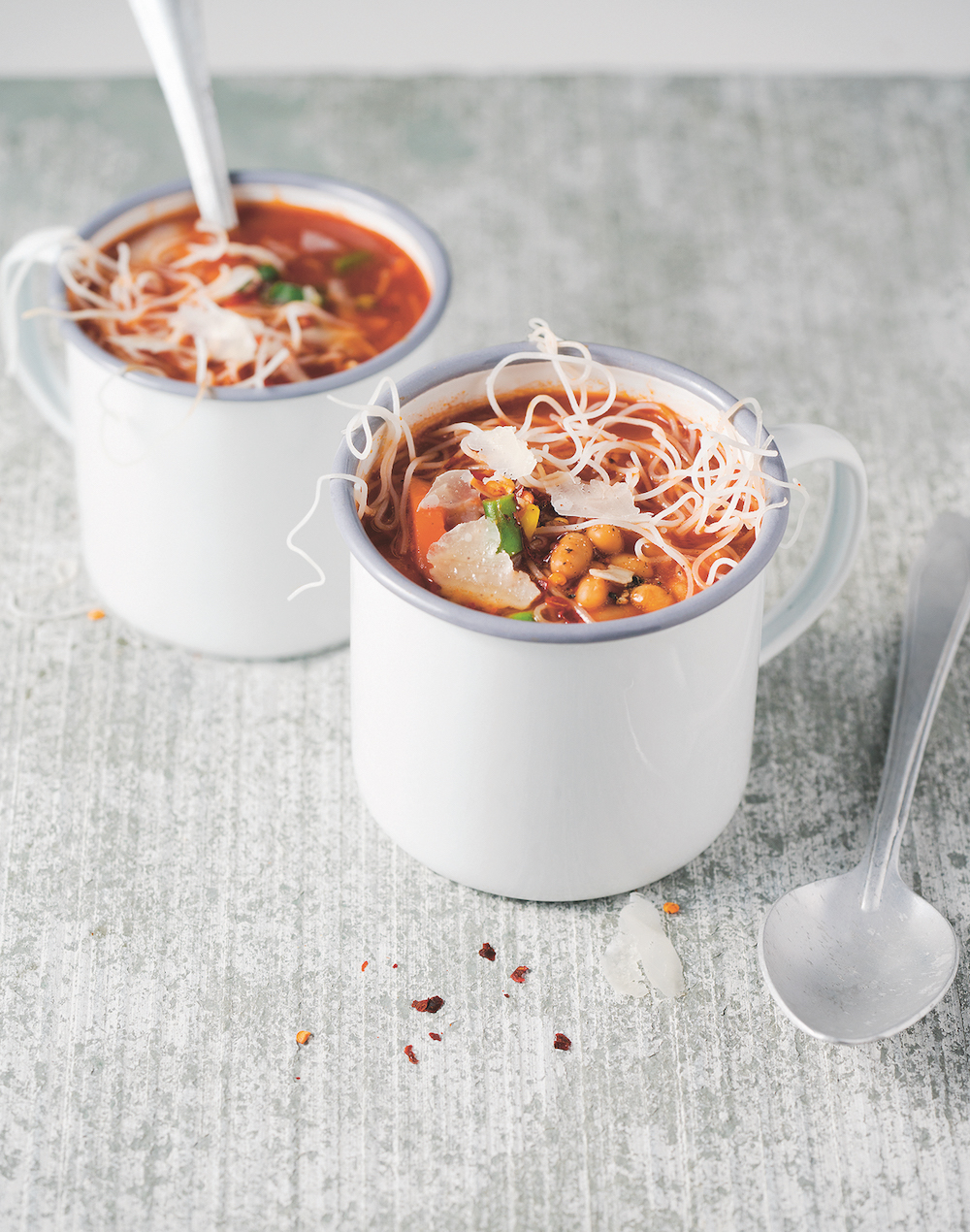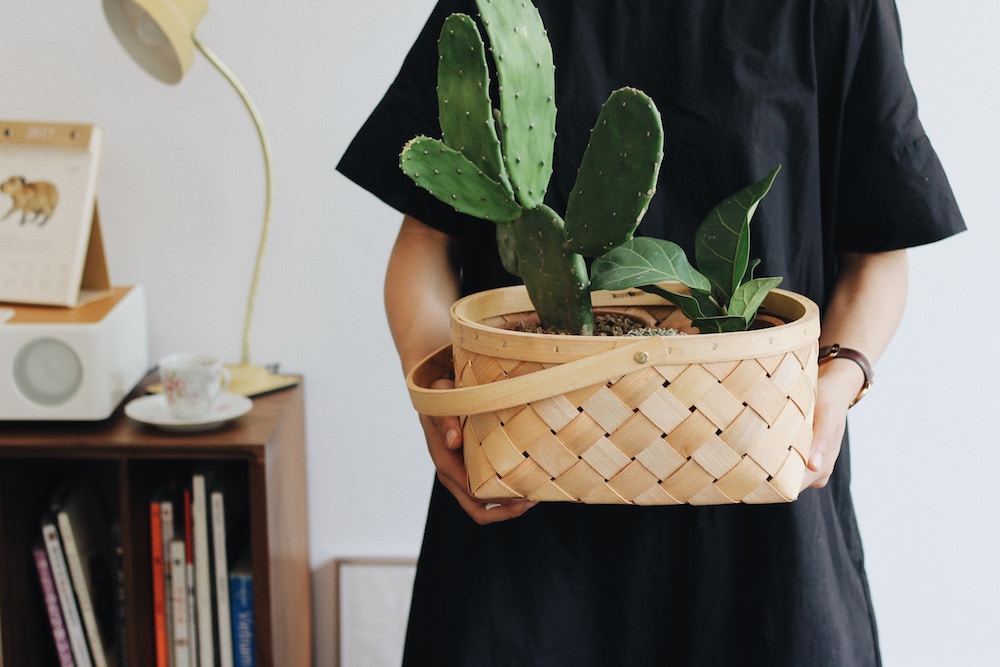More from the October issue:
Featured

Recipe | Lamb hotpot and mustardy greens
Blog
Taking Time to Live Well


Illustration: Joe Snow
Ideas for a more balanced life, Swedish style
Just as you’ve mastered hygge, along comes another Scandi concept to get your head around. Lagom (pronounced “law-ghum” or “lah-gum”) is Swedish and means “just the right amount”, or being satisfied with your lot. As Anna Brones explains in Live Lagom, “It’s a happiness drawn from contentment with now.”
Quality not quantity
Unlike hygge, lagom is not an excuse to stockpile candles. Roughly translating as “less is more”, it’s about valuing what you do have, whether it’s furniture or food.
Look for balance in all aspects Including work/life
Switch off, take proper holidays, embrace the Swedish fika coffee break (cinnamon buns encouraged).
Live in awareness of the wider picture
Taking just enough means there should be plenty for all, a concept that encourages respect for the environment.
Think more lagom
Ask yourself “Is this good enough?” rather than “Can I do better?”

Photography: Gary Congress
Harvest crab apples from a local wood or hedgerow while they’re ripe for picking and make this gorgeous tipple, which will be ready just in time for Christmas.
Serves 10–12
About 750g crab apples
70cl whisky
5 tbsp honey or sugar
3 slices of fresh ginger
1 Give your crab apples a good wash and dry. Halve them and place in a 1-litre sterilised jar. Top up the jar with whisky as you go. Swirl in the honey or sugar. Tuck in your ginger slices or any other spices you might want to add (a cinnamon stick, halved vanilla pod, cardamom, cloves).
2 Make sure the apples are fully covered by the whisky. Secure the lid. Let it infuse till Christmas, or longer if you can wait. If you can, leave it for up to 3–5 years it’ll veer towards the likes of Calvados. So, maybe make one for now, and one for later.
Recipe from How to Eat Brilliantly Every Day by Abel & Cole (Ebury Press).

Photo by Sara Rolin on Unsplash
Things you might want to do this month (no pressure!)
What would you add? Come over and tell us on Facebook or Twitter.

This year the award-winning Great Northern Contemporary Craft Fair celebrates its tenth anniversary and takes place from 12 -15 October at its new home of Upper Campfield Market, in Manchester city centre.

Buy and commission outstanding contemporary craft & design from 150 designer-makers, all selected for their excellence, from fine jewellery and fashion accessories to functional and statement pieces for the home. As well as a unique shopping experience, the event will feature artist demonstrations and talks giving visitors the chance to learn more about the inspiration, materials, making process and stories behind the work on sale.

The event will feature emerging and established makers, including those who have exhibited at the GNCCF for every one of its ten years and the curated ‘Great Northern Graduates’ will showcase best new Northern design talent to emerge from the UK’s creative courses.
The GNCCF has become a much-anticipated highlight in the North’s cultural calendar and one of the leading and most popular craft events in the UK. This not-for-profit event is supported by Arts Council England through Grant for the Arts with the aim of championing and promoting contemporary craft and designer-makers in the North.

We’ve teamed up with the Great Northern Contemporary Craft Fair to offer 2-4-1 tickets to our readers to this unique shopping and cultural event.
Great Northern Contemporary Craft Fair
Thursday 12 – Sunday 15 October 2017
Upper Campfield Market, Manchester
Ticket prices: In advance £6.50 (£5.50 concs)* / On the door £7.50 (£6.50 concs)
www.greatnorthernevents.co.uk
www.facebook.com/GNCCF / @GNCCF
For advance tickets please visit: https://www.eventbrite.co.uk/e/great-northern-contemporary-craft-fair-2017-tickets-36794223513
Exclusive code for 2-4-1 tickets for readers of The Simple Things: GNCCFST241
*Eventbrite booking fee applies to advance ticket bookings.

Photograph: Jonathan Cherry
This sewing project by Sarah Corbett reinvents the Post-it as a form of activism, giving a moment to pause and reflect
You may have been spurred into action by Sarah Corbett’s wisdom on page 34 of October's The Simple Things. If so, this project is a way of trying out a little craftivism (activism using craft) for yourself. Inspired by the simplicity of the Post-it Note, it was created as part of Bystander Revolution, a global anti-bullying initiative (bystanderrevolution.org). We’re so used to living and acting quickly, but a physical object like a Post-it Note can take us out of auto-pilot and remind us to stop and think. These are stitched rather than scrawled on, the act of hand-stitching bringing an opportunity to really consider our words and action, while the #crafterthought questions help to focus reflection on the message being created. You could keep your embroidered sticky notes or give them as gifts – or display them in your office, park or local café for people to see.
You will need
Post-it Notes
Biro or fabric invisible ink pen
Thin cotton fabric, ideally in Post-it Note colours
Black embroidery thread
Embroidery needle, ideally size 5–7
Embroidery hoop (not essential)
Bondaweb
Felt fabric, ideally in Post-it Note colours
Fabric scissors
1 Use a biro to write your message on a Post-it Note. Use one of the ideas opposite or come up with your own. Use the biro or fabric invisible ink pen to trace the message onto your cotton fabric (you can use a light box, or place it against a window or the light of
your computer screen to see the message through it).
2 Cut a finger-to-shoulder length of thread, thread your embroidery needle and embroider your message using a simple back stitch, with the help of an embroidery hoop, if you like. Use six strands of thread for thick words and two or three strands for smaller messages in thinner pen.
3 Cut out a piece of Bondaweb a little larger than your Post-it Note shape, and iron onto the back of your cotton fabric.
4 Place your Post-it Note on the back of your fabric, over the Bondaweb in the position you want your fabric Post-it, and cut around with fabric scissors to the shape and size of the real Post-it note.
5 Peel off your Bondaweb, then place the cotton, Bondaweb side facing out, onto your piece of felt fabric.
6 Heat your iron to low. Put your felt and cotton Post-it under a towel and briefly iron so the fabrics fuse. Cut your felt to the same size as the cotton square.
Place your handmade Post-it Note messages where they will have the most impact. Share your process and final piece online with followers or friends. You can tag @craftivists on Instagram or Twitter, or share on the Facebook page Craftivist Collective to encourage others to take part.
Project courtesy of craftivist-collective.com
Get hold of your copy of this month's The Simple Things - buy, download or subscribe
View the sampler here

Image: Stocksy
There are certain things in your home that are like good friends: they always cheer you up. This month we feel the love for a well made bed.
A bed can have many layers, each of varying quality, cost and sophistication. Take your pick from the smorgasbord of tog ratings and thread counts and assemble yours to your own specification.
The foundation of a good night’s sleep so worth investing in. The perceived wisdom is to change it every eight years, but this depends on the quality of the mattress.
A thin, often quilted, cover to keep the mattress unsullied.
An affordable option to changing your mattress. Padded with feathers or made from Memory Foam, it is an extra layer of support.
A necessity as the temperature drops, even when the central heating is on: little makes you sigh with pleasure like getting into a toasty bed.
Flat sheets beat fitted in our book: you can fold them easily before putting into the airing cupboard, and you get to show off hospital corners. Thread count of 300 is ideal; it’s high quality and launders well. Ironing sheets may be considered a waste of time, but slipping into a bed made with freshly laundered cotton sheet is a civilising thing.
There are too many choices of fillings and togs to go into here but a tog of 10.5 suits most, reduced to 4.5 in summer.
Tempting though patterns and designs are, plain colours are more versatile, with white top of the heap.
A better-quality pillow really does mean a better night’s sleep. Try a firmer pillow (mixture of down and feather) topped by a pure duck down pillow (expensive but dreamy) for a blissful combination.
Choose between the annoyingly named ‘housewife’ (simple and plain, fits snugly over pillow) and the Oxford (has a fabric border with a mitred corners). Ideally, they should match the duvet cover.
(a plain pillow case slipped inside) to prevent staining and ensure longevity of the pillow is a sensible addition.
An extra layer of warmth and handy for covering up rumpled bedding and toast crumbs.
Adds a touch of interior designer show-offiness and handy on chillier nights.
Can be changed at whim. Also useful for propping yourself up if reading in bed. Pile neatly on to an ottoman at night.
Turn to page 114 of October's The Simple Things for more on the comfort of beds, including how to get that elusive plumped up showroom look.

Photography: Jacqui Melville
There is great comfort to be had from a cup-a-soup – especially if made fresh from scratch
Serves 1
1 mug vegetable juice (such as V8 or tinned tomato soup)
40g tinned borlotti beans
60g frozen vegetables
15–20g vermicelli noodles
to serve – all optional
A drizzle of pesto
1⁄2 tbsp parmesan shavings
Fresh parsley
Pinch of chilli flakes
1 Pour the juice or soup into a mug and then add the borlotti beans, vegetables and noodles. Heat in the microwave on high for 2–3 mins. Alternatively, bring the mixture to boil in a saucepan on the hob. You want to heat it enough to cook the noodles and frozen veg thoroughly – around 4 mins.
2 Serve topped with a drizzle of pesto, parmesan shavings, fresh parsley leaves and chilli flakes, if using.
Taken from Pimp My Noodles by Kathy Kordalis (Hardie Grant).

Sometimes we need to look back to find our way ahead; it’s only by cherishing the past and what it teaches us that we can unearth forgotten wisdom to help us live our lives. History is punctuated with moments of change, but recognising what we have now and the things we love is just as important. It might be something simple like passing on a recipe for fruit cake or recording a weekly treasure in your journal; noticing the colours change on the trees, or exploring a derelict building. Observing and collecting are not merely pastimes, but also creative prompts for a more contented life.
Get hold of your copy of this month's The Simple Things - buy, download or subscribe
View the sampler here, buy back issues or try our sister mag, Oh Comely

Photography: Laura Edwards
Come the cold weather these are just the thing for tagines and stews
Makes 5 x 250ml jars
330ml white wine vinegar
350ml water
150g caster sugar
1⁄2 tsp sea salt
1 tsp black peppercorns
5 bay leaves
5 sprigs of rosemary, leaves stripped
5 large unwaxed lemons
1 Heat the vinegar, water and sugar together in a saucepan over a medium heat and simmer for no more than 2 mins until the sugar has dissolved completely. Add the salt and peppercorns. Take the pan off the heat and let the mixture cool.
2 Put a bay leaf and the leaves of 1 rosemary sprig into each sterilised jar.
3 Trim the ends off each lemon, then slice the lemons into six or eight rounds, depending on size. Put 1 sliced lemon into each jar.
4 Divide the cooled vinegar mixture between the jars. (If your lemons are on the small side, you may run out of liquid. Top up jars with a splash more vinegar and some boiling water.)
5 Seal the jars and store in a dark cupboard for at least 8–10 days. The lemons will keep for up to 4 months if the jars are unopened. Once opened, keep refrigerated and consume within 4 weeks.
A WORD ON STERILISING
Heat washed and rinsed jars, upside down, in a low oven (130C/Fan 110C/275F is fine) for half an hour. Build in some cooling time before you fill jars, but don’t let them go cold or they’ll crack, on filling. New lids are ideal or for used lids, boil in a pan of water for at least 10 minutes.
Turn to page 100 of September’s The Simple Things for four more preserve and pickle recipes. Adapted from Gatherings by Flora Shedden (Mitchell Beazley).

Photography: Holly Jolliffe
This pretty plant with its string of heart-shaped leaves is just lovely tumbling from the top of a cupboard; add a couple more to create a delicate screen.
“Let the soil dry out and then give them a good drenching,” says Alice Howard, owner of Botanique Workshop, artisan store and flower shop. “And mist the leaves, otherwise they can get scorched.”
They are easy to propagate, too. Each strand can be planted in a new pot to make a new one – in no time at all, your flat surfaces will be festooned with verdant delicacy.
String of hearts in terracotta pot, from £10; Brass mister, £14, both from Botanique Workshop, Exmouth Market, London EC1 (botaniqueworkshop.com)

Photography: Lisa Linder
A classic combo but in miniature, these little loaf cakes are ideal for a picnic or lunchbox, or make a sweet gift
COFFEE & WALNUT MINI LOAF CAKES
Makes 8
90g walnuts, toasted and chopped
150g unsalted butter, softened, plus a little extra for greasing
150g caster sugar
1 tbsp instant coffee granules
100ml milk
150g eggs (weight once shelled)
150g self-raising flour
1 tsp baking powder
for the icings:
2 tsp instant coffee granules
200g fondant icing sugar
2 tsp cocoa powder (optional)
for the decorations (optional)
Chocolate flowers
Toasted walnuts, crushed
you will need:
Individual loaf tins, approx 10x7x4cm
1 Preheat oven to 200C/Fan 180C/400F. Lightly grease the tins, then place a strip of baking parchment across the width of each, leaving an overhanging edge on each side.
2 Toast the walnuts in a skillet or frying pan set over a low heat for a few mins. Give the pan an occasional shake so they don’t burn. Leave to cool, then roughly chop into pieces.
3 Place the butter and sugar in the bowl of a free-standing mixer fitted with the paddle attachment and beat for approx 4 mins, until light and fluffy.
4 Dissolve the coffee granules with a few drops of milk, then mix with the rest of the milk before adding the eggs. Whisk to combine. Then, with the mixer running, add the liquid gradually, allowing each addition to be incorporated before adding the next, scraping the sides of the bowl as you go.
5 Sieve the flour and baking powder into a bowl, then re-sift into the mixer. Beat all together briefly, stopping the moment
everything comes together. Fold in the nuts, then share the batter equally between tins.
6 Bake on a baking sheet in the middle of the oven, checking them after 20 mins. Insert a skewer into the centre of each cake; if it comes out clean, they are ready. If not, return to the oven for a further 5 mins. When baked, turn out the cakes and cool on a wire rack.
7 To make the coffee icing, start by dissolving the coffee granules with a few drops of hot water. Add the coffee solution, a little at a time, to 150g of the icing sugar and mix until it has a thick, coating consistency. If the icing is
too runny, add more icing sugar. If you want to make cocoa icing too, add the cocoa powder to the remaining 50g of icing sugar, then slowly add drops of water to achieve the same consistency as the coffee icing.
8 Once the cakes have cooled, drizzle on the icings, adding chocolate flowers or toasted walnuts for decoration.
Recipe from Soulful Baker by Julie Jones (Jacqui Small). Cake in the House is our monthly recipe feature - get a cake recipe every month in The Simple Things!

The average household in the UK produces more than a tonne of waste every year – which adds up to a sobering 31 million tonnes annually.
While campaigners are trying to tackle this in a variety of ways, one creative approach is to see waste as a material for art. The four British makers featured on page 74 of September’s The Simple Things look to our rubbish for inspiration, encouraging the viewer to see waste denim, metal, plastic and paper in a whole new light.

It’s hard to imagine an item of clothing more universal than a pair of jeans. Denim is a material that we all know and feel comfortable with. For Huddersfield artist Ian Berry, however, it forms his palette, from which he constructs intricate images. Beginning with his simple observation of the varied shades of blue in a pile of jeans, he has used old denim to create melancholy urban images, traditional pub scenes and instantly recognisable portraits from his layers of cut and constructed denim. Jeans are so familiar we’re used to taking the way they look for granted – Ian’s work encourages us to look again. ianberry.org
Turn to page 74 for three more artists.

Illustration: Joe Snow
Quite easy – if you’re a gum-chewing, coffee-guzzling daydreamer with incredible self belief...
Short term:
Drink coffee after a task. Boosts your chances of remembering it (also works with chewing gum or doodling while you do it).
Listen to music you like. This increases dopamine levels, in turn thought to improve cognition.
Daydream. Daydreamers do better on tests than their more focussed peers.
Long term:
Exercise. Increases the level of a protein that helps in growing new neurons.
Eat brain-friendly food. Food with Omega-3 fatty acids like fish, as well as B vitamins (think green veg, milk and shellfish), are believed to be good for brains.
Clean your teeth properly. Having no teeth is linked to lesser cognitive abilities.
Really long term:
Stick around. Over subsequent decades, IQ scores have been getting better and better – so, thanks simply to when you were born, you’re probably smarter than your great grandmother.
And a super easy short-term fix...
Studies have shown that just believing you can be cleverer actually makes it come true.


Make your plants pretty as a picture
You will need:
An old picture frame
Thin plywood
Screws and a drill
Chicken wire
Compost mixed with horticultural grit or sand
Dibber
Succulents: try a mix of hanging plants and rosettes
1 Remove any glass from the frame and replace with chicken wire.
2 Fashion a box frame to fit on the back of the frame using the plywood and attach.
3 At the bottom of the box, drill holes to allow for drainage.
4 Fill the box with compost mix.
5 Create holes between sections of the wire mesh, adding one of your plants into each hole.
6 Leave to stand for a few weeks to bed in before hanging, so that your plants don’t fall out!

Tasty, filling and pleasingly wholesome. The fact that you can prepare this Bircher muesli the day before only adds to your sense of smug satisfaction
Serves 4
200g gluten-free oats
200ml coconut milk
100ml apple juice
1 tbsp chai seeds
1 tsp honey, plus extra to drizzle
30g raisins, plus extra to serve
1⁄2 tsp ground cinnamon, extra to dust
2 apples, coarsely grated
1 tbsp mixed seeds (sunflower, flaxseed, linseed and sesame), to serve
1 In a bowl, place the oats, coconut milk, apple juice, chai seeds, tsp of honey, raisins and 1⁄2 tsp of cinnamon. Mix thoroughly, cover and leave overnight in the fridge.
2 When ready to serve, divide the Bircher into bowls, top with grated apple, raisins, cinnamon, mixed seeds and a good drizzle of honey.

Photo by Lizzie/Unsplash

Image: Getty
The lacrosse and midnight feasts of boarding school novels are far removed from real life for most of us. So why does our love of such girlhood fiction endure?
On page 86 of September’s The Simple Things, we look at the school run of days gone by - from The Worst Witch to the Chalet School.
Here, we outline how to build your own Malory Towers. Our fictitious boarding school primer sets out the jolly necessary ingredients
Must be flawed but only to a small extent. Will either start off hating the school (see the O’Sullivan Twins and Elizabeth, The Naughtiest Girl in the School) or will be desperate to please but have to work to overcome said character flaw (see Darrell and her oft-referenced hot temper).
The most disliked girl in the school will usually have committed a crime so heinous as to scoff an entire box of chocs in bed or be secretly working class and ‘put on airs and graces’. See Pauline at St Clare’s who is ‘outed’ as working class when her mother visits and is mistaken for a school cook – the shame... Basically, being cowardly, nouveau riche or a little plump is equal to being Carlos the Jackal in boarding school land.
Usually has short hair and is ‘as brown as an acorn’ (to make clear her love of the outdoors). May well have 16 older brothers.
Will have a ‘drawl’ which grates on the other girls and probably aspirations of becoming
a Hollywood actress. Usually is also lazy and dislikes PE.
Tends to be ‘dark’ to denote some sort of European exoticism. Will have a hilarious accent and mispronounce words to the delight of her peers who all have English
as a first language and consider themselves superior in this respect.
Generally all headmistresses are solid and kind. Miss Grayling of Malory Towers, particularly so.
Usually identical to ensure maximum confusion and top japes.
Probably has ‘sparkling eyes’ to show their good-humoured mischief and a tuck box full of fake dog poo, invisible string and itching powder.
Must be of an artistic bent, for example, skilled in music or painting. Being academic is merely expected.

Photograph: Lottie Storey
See, do, stay, love the UK. This month: Lottie Storey heads to The Culpeper, London - much more than a pub with rooms
Our regular travel series comes from online UK travel guide This is Your Kingdom, whose handpicked contributors explore favourite places, special finds and great goings on.
You can read about one we love each month in The Simple Things – turn to page 62 of the September issue for more of this urban adventure – and plenty of others at thisisyourkingdom.co.uk.

Lottie Storey is The Simple Things’ digital editor and a contributor to thisisyourkingdom.co.uk. Find her on Instagram @lottie_storey and her Bristol-based travel and lifestyle blog, oysterandpearl.co.uk.
We celebrate slowing down, enjoying what you have, making the most of where you live, enjoying the company of of friends and family, and feeding them well. We like to grow some of our own vegetables, visit local markets, rummage for vintage finds, and decorate our home with the plunder. We love being outdoors and enjoy the satisfaction that comes with a job well done.